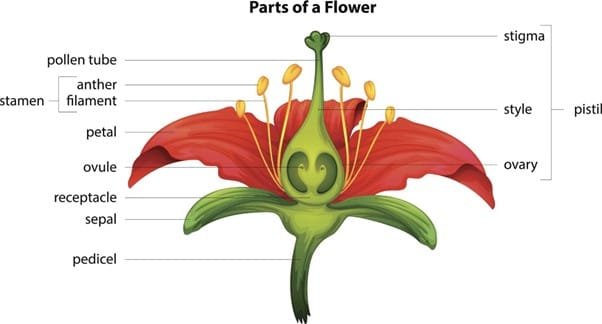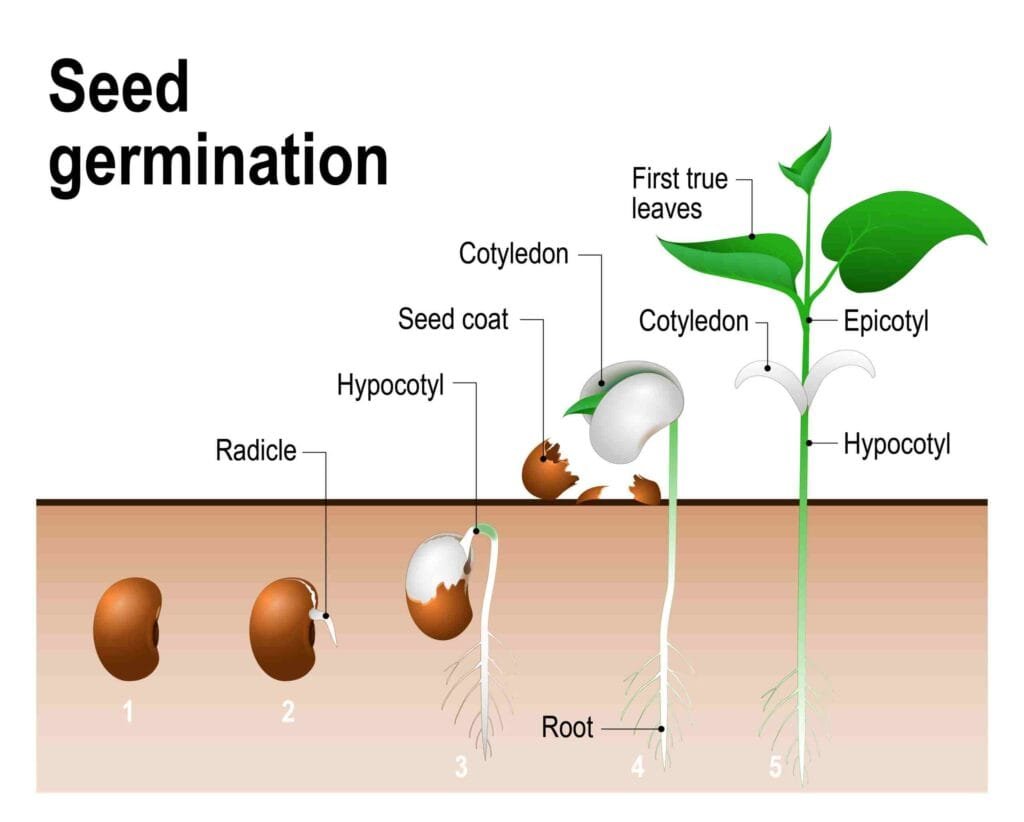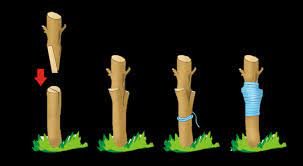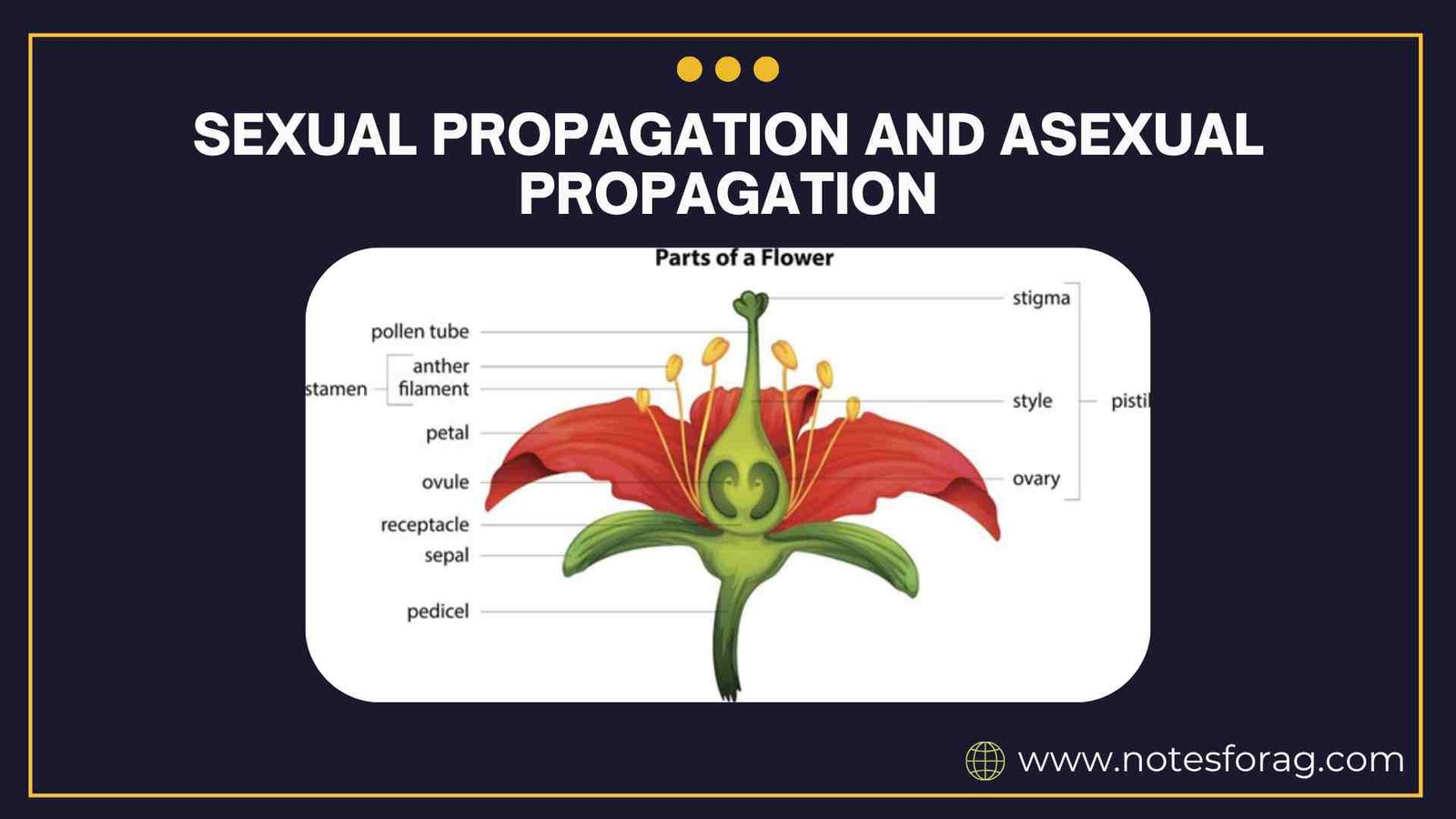INTRODUCTION
Plant propagation is the process of creating new plants from existing ones. It is a fundamental aspect of horticulture, agriculture, and plant breeding. Two main methods of propagation exist: sexual propagation, which involves the use of seeds formed through the fusion of male and female gametes, and asexual propagation, which produces new plants without the formation of seeds or spores. Each method has its unique advantages and applications, depending on the type of plant and the purpose of cultivation.
Summary of Sexual Propagation
- Sexual propagation uses seeds created by fertilization, offering genetic diversity and new variety development but often yields non-uniform offspring and slower maturity.
- Asexual propagation clones plants using parts like cuttings, grafts, or tissue culture, ensuring true-to-type results and faster production, though it risks disease spread and lacks genetic variation.
- Choice of method depends on crop purpose use sexual propagation for breeding and genetic diversity, and asexual propagation for consistency, speed, and maintaining elite cultivars.
Table of Contents
SEXUAL PROPAGATION

Definition
Sexual propagation is the process of reproducing plants through seeds. It involves the union of male (pollen) and female (ovule) gametes resulting in the formation of a zygote, which develops into a seed. This method is the natural way of reproducing many plants and plays a vital role in preserving biodiversity and developing new varieties through genetic recombination.
Advantages of Sexual Propagation
Genetic Variation
Sexual reproduction introduces genetic diversity among offspring. This variation is essential for the evolution and adaptability of plant species. It allows crops to withstand pests, diseases, and changing environmental conditions. Diverse genetic traits also open opportunities for plant breeders to develop new and improved varieties.
Hybrid Development
This method supports the development of hybrid varieties that combine the best traits of two parent plants. Hybrids often exhibit superior characteristics such as higher productivity, disease resistance, better flavor, and improved shelf life, which make them commercially valuable and desirable in farming.
Longevity
Plants propagated sexually typically have deeper root systems and robust structures. These traits contribute to longer lifespans and better resistance to adverse weather conditions like drought, floods, and wind damage, making them more suitable for long-term cultivation.
Economical Method
Sexual propagation is generally cost-effective for mass production. Seeds are easy to produce, store, and transport over long distances. This method is particularly useful for annual and biennial crops where large numbers of plants are needed within a short time.
Disadvantages of Sexual Propagation
Lack of Uniformity
Because each seed is genetically unique, the resulting plants can differ in appearance, growth habit, yield, fruit quality, and maturity time. This variability can be problematic in commercial agriculture, where uniformity is crucial for processing and market standards.
Time-Consuming
Plants grown from seeds often take longer to mature and bear fruits or flowers. This is especially true for woody perennial plants like fruit trees, which may take several years before they become productive.
Germination Problems
Seeds may have dormancy issues that delay or prevent germination. Some seeds require specific environmental conditions or pre-treatment (scarification or stratification) to germinate, which complicates the propagation process.
Not Suitable for All Plants
Many ornamental, fruit, and hybrid plants do not produce true-to-type offspring when grown from seeds. These plants are better propagated asexually to retain desirable characteristics.
Seed Structure and Formation
Seeds are formed as a result of fertilization between male and female gametes. A typical seed contains three essential parts:
Embryo
The embryo is the miniature plant enclosed within the seed. It includes the radicle (future root), plumule (future shoot), and cotyledons (seed leaves) that support early growth after germination.
Endosperm
The endosperm is a tissue that stores nutrients required by the embryo during germination. It acts as a food reservoir until the seedling becomes photosynthetically active.
Seed Coat
The seed coat is the outer protective layer that shields the embryo from mechanical injury, pathogens, and desiccation. It also regulates the uptake of water necessary for germination.
Seed Germination

Germination is the process by which a seed develops into a new plant. For successful germination, seeds require favorable conditions such as moisture, oxygen, and optimal temperature. The process begins with the absorption of water, followed by the activation of enzymes, cellular growth, and the emergence of the radicle and plumule.
Types of Sexual Propagation
Direct Seeding
In this method, seeds are sown directly in the field where the plant is intended to grow. This is commonly used for cereals, pulses, and some vegetables. It reduces transplant shock and labor cost but requires careful soil preparation and weed control.
Nursery Transplanting
Seeds are first germinated in a controlled nursery environment. Once the seedlings attain adequate growth, they are transplanted to the main field. This method offers better survival rates and enables early-stage care, especially for crops like tomatoes, peppers, and tree saplings.
ASEXUAL PROPAGATION

Definition
Asexual propagation, also known as vegetative propagation, is the process of reproducing plants using parts of the parent plant such as stems, roots, or leaves. Unlike sexual propagation, it does not involve seed formation or fertilization, and the resulting plants are genetically identical to the parent.
Advantages of Asexual Propagation
Genetic Uniformity
Since the new plants are clones of the parent plant, they inherit all the exact traits. This ensures consistency in fruit size, color, taste, yield, and disease resistance, which is critical for commercial horticulture and export-quality production.
Faster Maturity
Asexually propagated plants often reach maturity and start producing flowers or fruits more quickly than those grown from seeds. This trait is beneficial for farmers and nurseries looking for quicker returns on investment.
Preservation of Desirable Traits
This method is ideal for maintaining elite or high-performing plant varieties. Rare species, hybrids, or genetically modified plants can be propagated reliably without the risk of genetic segregation.
Useful for Sterile Plants
Some plants do not produce viable seeds or are sterile by nature. Asexual propagation offers the only means of multiplying such plants. It is extensively used in propagating banana, sugarcane, and many ornamental plants.
Disadvantages of Asexual Propagation
Disease Transmission
If the mother plant is infected with pathogens or viruses, the same can be transferred to the offspring. Proper sanitation, sterilized tools, and disease-free mother stock are essential to mitigate this risk.
Limited Genetic Diversity
Lack of genetic variability in clones can make the entire crop vulnerable to pests, diseases, or climatic extremes. A single threat can destroy the entire genetically identical population.
Labor Intensive
Asexual propagation techniques often require skilled labor and more time than sowing seeds. Methods like grafting, layering, or tissue culture demand precision, equipment, and technical knowledge.
Methods of Asexual Propagation
Cutting
This involves removing a part of a plant such as a stem, root, or leaf and placing it in a suitable medium to encourage root development. Common in plants like rose, hibiscus, and sugarcane, this method is simple and widely practiced in home gardening and nurseries.
Layering
A stem is bent to the ground and partially buried in soil while still attached to the parent plant. Roots develop at the buried section, and once established, the new plant is separated. Layering is common in plants like jasmine, guava, and blackberry.
Grafting and Budding
This technique involves joining parts from two different plants. A scion (upper part) is grafted onto a rootstock (lower part) to combine desirable traits of both. Grafting is common in fruit crops like mango, citrus, and apple, while budding is a variant used for roses and stone fruits.
Division
Mature plants are divided into multiple sections, each having roots and shoots, and replanted as independent plants. This method is suitable for herbaceous perennials like ginger, banana, and ornamental grasses.
Tissue Culture
Also known as micropropagation, this is a high-tech method where plant cells or tissues are grown in sterile, nutrient-rich media under controlled conditions. It enables rapid, large-scale multiplication of disease-free and uniform plants, ideal for floriculture, forestry, and export-oriented crops.
Applications of Asexual Propagation
Horticulture and Floriculture
Asexual propagation is extensively used in growing ornamental plants, flowers, and fruit trees. It allows nurseries to produce large numbers of uniform plants that meet market demands for color, size, and flowering time.
Conservation
Rare, endangered, and native plant species can be preserved using vegetative propagation. This method helps in habitat restoration and biodiversity conservation without depleting natural populations.
Commercial Farming
For large-scale, commercial fruit and vegetable farming, uniformity and predictability are crucial. Asexual propagation ensures consistent produce, synchronized harvesting, and efficient packaging and marketing.
CONCLUSION
Both sexual and asexual propagation methods are vital for successful plant production, each serving different objectives in agriculture and horticulture. Sexual propagation introduces genetic diversity and enables the development of new plant varieties, which is important for evolution, resilience, and adapting to environmental stress. It also remains the most economical and accessible method for crops where seed propagation is efficient and reliable.
On the other hand, asexual propagation ensures uniformity in plant characteristics, faster crop production, and preservation of elite traits. It is indispensable in commercial horticulture, ornamental gardening, and propagation of sterile or hybrid plants. The ability to reproduce identical plants with known qualities greatly benefits farmers and nursery operators who aim to meet market standards consistently.
While sexual propagation supports biodiversity and breeding advancements, asexual propagation focuses on quality, speed, and reliability. Both methods complement each other and are often used in combination depending on the crop and desired outcome. Understanding the strengths and limitations of each technique allows cultivators to make informed choices and adopt propagation strategies that enhance productivity, profitability, and sustainability.
Ultimately, mastering plant propagation empowers growers to contribute to food security, rural livelihoods, and environmental conservation on both local and global scales.
Frequently Asked Questions (FAQs)
Why use sexual propagation in plant breeding?
Sexual propagation is essential in plant breeding as it creates genetically diverse offspring, enabling the selection and development of superior hybrids with improved traits like disease resistance and higher productivity.
What is the difference between sexual and asexual plant propagation?
Sexual propagation involves producing plants from seeds through fertilization, leading to genetic variation and adaptability, while asexual propagation uses vegetative parts to clone genetically identical plants for uniform growth and yield.
Which method produces faster-maturing plants?
Asexual propagation produces faster-maturing plants because it skips seed germination and juvenile stages, allowing direct growth from mature tissues for quicker flowering and fruiting.
Related Articles

